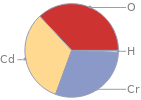Input interpretation

cadmium dichromate monohydrate | elemental composition
Result

Find the elemental composition for cadmium dichromate monohydrate in terms of the atom and mass percents: atom percent = N_i/N_atoms × 100% mass percent = (N_im_i)/m × 100% Plan: • Write the chemical formula and gather atomic masses from the periodic table. • Determine values for N_i, m_i, N_atoms and m using these items. • Finally, compute the percents and check the results. Write the chemical formula: CdCr_2O_7·H_2O Use the chemical formula to count the number of atoms, N_i, for each element and find the total number of atoms, N_atoms, per molecule: | number of atoms Cd (cadmium) | 1 Cr (chromium) | 2 H (hydrogen) | 2 O (oxygen) | 8 N_atoms = 1 + 2 + 2 + 8 = 13 Divide each N_i by N_atoms to calculate atom fractions. Then use the property that atom fractions must sum to one to check the work: | number of atoms | atom fraction Cd (cadmium) | 1 | 1/13 Cr (chromium) | 2 | 2/13 H (hydrogen) | 2 | 2/13 O (oxygen) | 8 | 8/13 Check: 1/13 + 2/13 + 2/13 + 8/13 = 1 Compute atom percents using the atom fractions: | number of atoms | atom percent Cd (cadmium) | 1 | 1/13 × 100% = 7.69% Cr (chromium) | 2 | 2/13 × 100% = 15.4% H (hydrogen) | 2 | 2/13 × 100% = 15.4% O (oxygen) | 8 | 8/13 × 100% = 61.5% Look up the atomic mass, m_i, in unified atomic mass units, u, for each element in the periodic table: | number of atoms | atom percent | atomic mass/u Cd (cadmium) | 1 | 7.69% | 112.414 Cr (chromium) | 2 | 15.4% | 51.9961 H (hydrogen) | 2 | 15.4% | 1.008 O (oxygen) | 8 | 61.5% | 15.999 Multiply N_i by m_i to compute the mass for each element. Then sum those values to compute the molecular mass, m: | number of atoms | atom percent | atomic mass/u | mass/u Cd (cadmium) | 1 | 7.69% | 112.414 | 1 × 112.414 = 112.414 Cr (chromium) | 2 | 15.4% | 51.9961 | 2 × 51.9961 = 103.9922 H (hydrogen) | 2 | 15.4% | 1.008 | 2 × 1.008 = 2.016 O (oxygen) | 8 | 61.5% | 15.999 | 8 × 15.999 = 127.992 m = 112.414 u + 103.9922 u + 2.016 u + 127.992 u = 346.4142 u Divide the mass for each element by m to calculate mass fractions. Then use the property that mass fractions must sum to one to check the work: | number of atoms | atom percent | mass fraction Cd (cadmium) | 1 | 7.69% | 112.414/346.4142 Cr (chromium) | 2 | 15.4% | 103.9922/346.4142 H (hydrogen) | 2 | 15.4% | 2.016/346.4142 O (oxygen) | 8 | 61.5% | 127.992/346.4142 Check: 112.414/346.4142 + 103.9922/346.4142 + 2.016/346.4142 + 127.992/346.4142 = 1 Compute mass percents using the mass fractions: Answer: | | | number of atoms | atom percent | mass percent Cd (cadmium) | 1 | 7.69% | 112.414/346.4142 × 100% = 32.45% Cr (chromium) | 2 | 15.4% | 103.9922/346.4142 × 100% = 30.02% H (hydrogen) | 2 | 15.4% | 2.016/346.4142 × 100% = 0.5820% O (oxygen) | 8 | 61.5% | 127.992/346.4142 × 100% = 36.95%
Mass fraction pie chart

Mass fraction pie chart